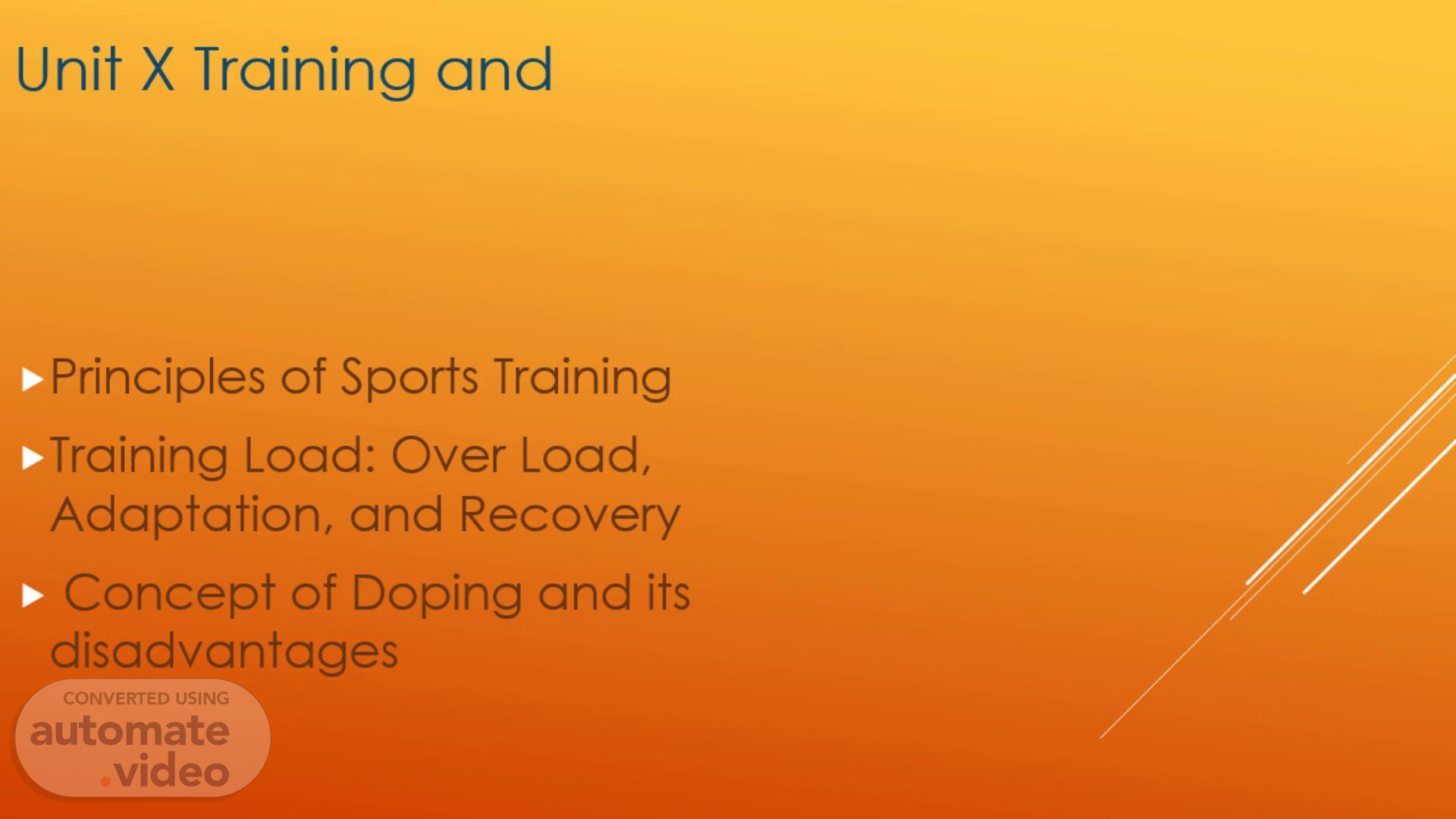
Unit X Training and Doping in Sports
Scene 1 (0s)
Unit X Training and Doping in Sports. Principles of Sports Training Training Load: Over Load, Adaptation, and Recovery Concept of Doping and its disadvantages.
Scene 2 (10s)
[image]. Training is the process of preparing human resources for performing a particular task or activity. Sports performance training simply is a type of training that is designed to improve the sportsperson’s fitness level and ability to perform in a given sport. It includes corrective and restorative exercises, strength training, conditioning and cardiovascular training, sports specific technique s and drills, periodization, nutritional advice, mental and psychological training by a qualified trainer..
Scene 3 (31s)
CONCEPT OF TRANING. Concept of Training : Training for achieving something of for competition is not a new idea, with the passage of time, more time and efforts are being devoted to training of preparation for competitions, with the invention of new techniques every now and then in the field of athletics, weight training methods has shown very encouraging results. Training for any game or event has become very technical and a scientific approach is needed to get the desired results..
Scene 4 (54s)
“Sports training is the preparation of an athlete on scientific based principles in sequential manner to attain optimum performance in their desired competition.”.
Scene 5 (1m 4s)
PRINCIPLE OF CONTINUITY PRINCIPLE OF PROGRESSIVE LOAD PRINCIPLE OF OVERLOAD PRINCIPLE OF INDIVIDUAL DIFFERENCES PRINCIPLE OF WARMING UP AND COOLING DOWN PRINCIPLE OF VARIETY PRINCIPLE OF SPECIFICITY: PRINCIPAL OF JOURNAL AND SPECIFICATION PREPRATION PRINCIPLE OF CYCLIST PRINCIPLE OF ACTIVE INVOLVEMENT.
Scene 6 (1m 19s)
PRINCIPAL OF OVERLOAD. Principle of Overload: Load, in sports training, is known as the demand, that can be physical, physiological or psychological, put on the body to enhance the performance of the individual. The key point to note, while planning a training session, is the load should be greater than the normal load to aid adaptation process and thus facilitate the performance enhancement.
Scene 7 (1m 39s)
Principle of Progression of load. Principle of Progression of load: As we discussed above, training load must be greater than the normal load. This principle testifies that training load must be increased gradually in order to avoid any unwanted tension on the muscles of the individual by increasing the load slowly and in accordance with the capabilities of the sports person..
Scene 8 (1m 59s)
Principle of Rest and Recovery. Principle of Rest and Recovery: It is evident that during rest, the body restores itself and become better and stronger than before. Both short periods, like hours between multiple sessions, and longer periods, like days or weeks to recover from a long season, are required to ensure that the athlete does not suffer from exhaustion or an overuse injury. Therefore, a training plan must be designed in such a manner that proper rest recovery can take place in between the training sessions..
Scene 9 (2m 23s)
Meaning of doping. . Doping may be defined as the use of chemical substances, foreign to the body, to improve athletic performance..
Scene 10 (2m 36s)
Concept & Classification of Doping. Doping can be classified into two major categories..
Scene 11 (3m 1s)
Stimulants: Stimulants are drugs which increase alertness and reduce fatigue and may increase competitiveness and hostility. They are banned because they can produce a psychological and physical stimulus which may improve athletic performance..
Scene 12 (3m 58s)
Prohibited Substances and Methods. The International Olympic Committee and the US Olympic Committee are among 625 sports organizations world wide that have adopted the World Anti Doping Agency (WADA) “Code” banning many performance enhancing substances and methods..
Scene 13 (4m 23s)
1. Increased heart rate and Blood pressure 2. Sexual dysfunction 3. Features like male in females 4. Physical and mental weakness 5. Complications like stroke, cardiac problems and even death 6. Breast enlargement in males 7. Premature baldness 8. Enlargement of the prostate gland 9. Irregularity in menstruation 10. Problem of depression & aggression.
Scene 14 (4m 44s)
Name of the Stimulants. 1. Adrafinil 4. Cathine 7. Fencamine 10. Modafinil 2. Amfepramone 5. Cocaine 8. Hetaminol 3. Bromantan 6. Etamivan 9. Mesocarb.
Scene 15 (5m 13s)
Beta Blockers. 1. Acetazolamide 4. Canreone 7. Metolazone 10. Triamterene 2. Amiloride 5. Furosemide 8. Spironolactone 3. Bumetanide 6. Indapamide 9. Thiazides.
Scene 16 (5m 37s)
Athletes’ Responsibilities. Athletes have certain responsibilities when being tested. It is important that athletes know and understand their responsibilities. Under the World Anti-Doping Code, ignorance is no excuse..
Scene 17 (6m 2s)
Under the terms of the WDSF Anti-Doping Code and the World Anti Doping Code, all athletes are required to assume certain obligations. In essence, all athletes must:.
Scene 18 (6m 32s)
Side Effects of Prohibited Substances. There are many side effects of Prohibited Substances. The side effects are like:.
Scene 19 (7m 4s)
Ergogenic aids and Doping in Sports. Nutritional supplements which claim to have performance enhancing effect are called ergogenic acid for Example:.
Scene 20 (7m 21s)
Doping Control Procedure. Drug testing has become an increasingly large part of both professional and amateur sports. An athlete can be called for drug testing at any time, in or out of competition. During competition, some sports only carry out drug testing on the winning team or top three competitors. Others test by random selection from all competitors..
Scene 21 (7m 52s)
Out of Competition Testing. Out of competition doping controls are one of the most powerful means of deterrence and detecting the use of forbidden substances, doping..
Scene 22 (8m 33s)
Thanks! MIRROR FRIENöLY.